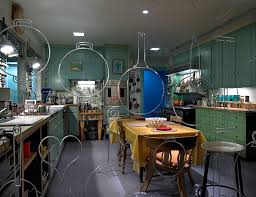By Professor Tiffany Banks On Tuesday, September 30th , students from my COMM 108: Foundations…
A rich afternoon awaited our group on March 31 with presentations from the Smithsonian Asian Pacific American Center (APAC) and the National Museum of the American Latino (NMAL).
Andrea Kim Neighbors, Manager of Education Initiatives for the APAC, began the afternoon with a review of the work being done to break down Asian Pacific American bias. This small unit of the Smithsonian is celebrating its 25th anniversary, and continues to do amazing work with a small but highly talented staff. The aim of APAC is to represent as many Asian Pacific American stories as possible through their online platforms and live events. She highlighted two resources in particular. The first, “We are not a Stereotype” provides educators with resources and videos on topics such as migration, occupation, racial and gender identities, and cross-community building, and includes tools for helping students learn and grapple with these topics. A second, the website, “Learning Together by Building Connections,” is filled with interviews with Asian American and Pacific Islander (AAPI) community members, links to community-created educational resources as well as book recommendations and ideas for discussion. While aimed toward grades K-12, our Fellows quickly realized that this site had a number of resources that could be adapted for working with our student population.
The second part of the afternoon was led by members of the National Museum of the American Latino (NMAL) whose first gallery will be opening this spring in the National Museum of American History. Our presenters were Emily Key, the Director of Education, Adrián Aldaba, a Manager of Education and Public Programs and Natalia Febo, Community Engagement and Volunteer Coordinator at NMAL. Their presentation, “¡Presente! Elevating Latino History and Civic Engagement in the times of COVID-19.” gave the Fellows an overview of the work that has gone into developing the Molina Family Latin Gallery and the museum’s active learning programs during the pandemic. Fellows heard how they approached the task of developing this initial gallery which will represent the full museum that will be built in the years to come. The staff of the museum has worked hard to develop exhibits which will represent the history of the American Latino while also including contemporary voices. There will be a dedicated Learning Lounge, which will provide families the opportunity to explore and learn together. Online bilingual resources including those in the Smithsonian Digital Learning Lab such as Nuestra América: 30 Inspiring Latinas/Latinos Who Have Shaped the United States, and Art for Social Change: Conversations on Protest and the Voting Rights Act, have already provided ways to engage the American Latino community throughout the country, an outreach effort that will continue. Community engagement programs held at local Community Centers, Family Centers Adult Education Schools and health clinics are seen as integral to their overall mission.
An opportunity for questions and discussion finished off another wonderful seminar.





This Post Has 0 Comments